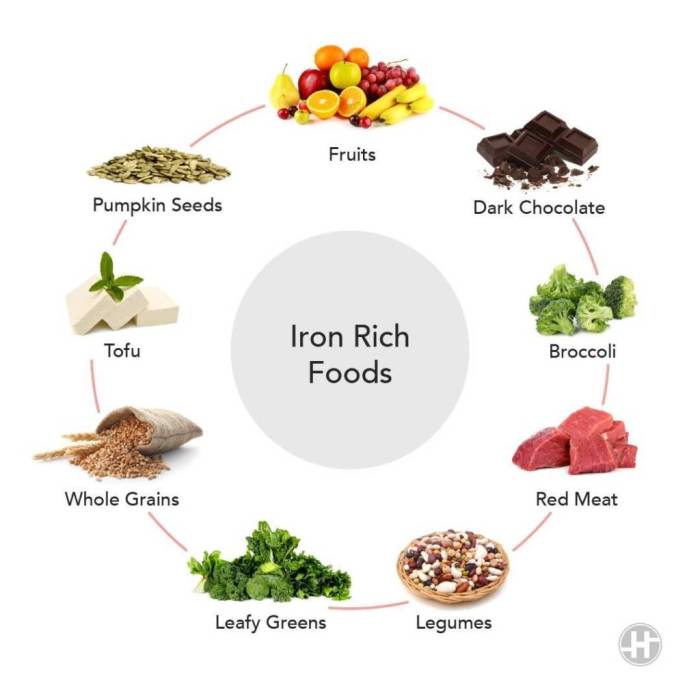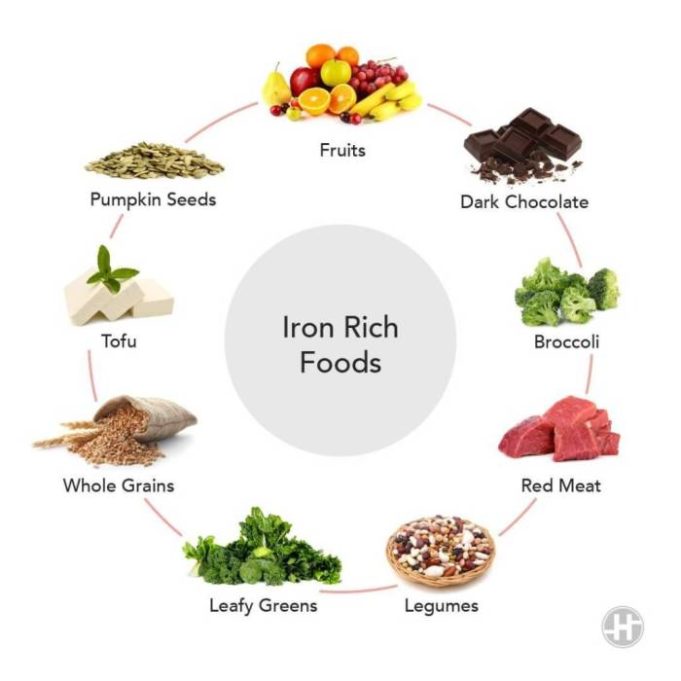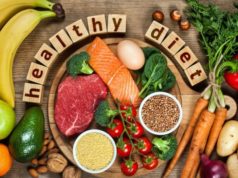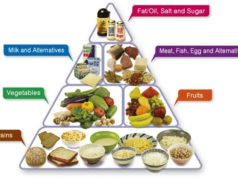How to add iron to diet – How to add iron to your diet is a crucial topic, especially for those who experience iron deficiency. Iron is a vital mineral that plays a critical role in transporting oxygen throughout your body. Without enough iron, your body can’t function properly, leading to fatigue, weakness, and even anemia. Fortunately, incorporating iron-rich foods into your diet can significantly improve your iron levels and overall health.
This guide explores the importance of iron, the signs of deficiency, and practical strategies to boost your iron intake. We’ll delve into the world of iron-rich foods, provide tips for maximizing absorption, and discuss the role of supplements and lifestyle changes.
Understanding Iron Deficiency
Iron is a vital mineral that plays a crucial role in various bodily functions, including the production of red blood cells, which carry oxygen throughout the body. Without sufficient iron, your body cannot produce enough healthy red blood cells, leading to iron deficiency anemia.
Iron Deficiency Anemia Symptoms
Iron deficiency anemia can manifest in a range of symptoms, affecting both physical and mental well-being. It is important to recognize these signs and seek medical advice if you experience any of them.
- Fatigue and Weakness: Feeling tired and weak is a common symptom of iron deficiency anemia, as your body lacks enough oxygen to function properly.
- Pale Skin: Reduced iron levels can cause your skin to appear paler than usual due to the lack of red blood cells.
- Shortness of Breath: Iron deficiency can affect your ability to transport oxygen efficiently, leading to shortness of breath, especially during physical activity.
- Headaches: Iron deficiency can contribute to headaches, particularly in cases of severe anemia.
- Dizziness and Lightheadedness: The lack of oxygen in the brain can cause dizziness and lightheadedness.
- Cold Hands and Feet: Iron deficiency can impair blood flow to extremities, leading to cold hands and feet.
- Brittle Nails: Iron deficiency can affect nail health, making them brittle and prone to breakage.
- Restless Legs Syndrome: This condition, characterized by an irresistible urge to move the legs, can be associated with iron deficiency.
- Pica: An unusual craving for non-food items, such as ice, clay, or dirt, can be a sign of iron deficiency.
Risks Associated with Iron Deficiency
Iron deficiency can have various health consequences, particularly if left untreated.
- Impaired Growth and Development: Iron deficiency can hinder growth and development in children, affecting their cognitive abilities and physical stature.
- Pregnancy Complications: Iron deficiency during pregnancy can increase the risk of premature birth, low birth weight, and other complications for both mother and baby.
- Heart Problems: Severe iron deficiency can strain the heart, leading to an enlarged heart and other cardiovascular issues.
- Reduced Immunity: Iron deficiency can weaken the immune system, making individuals more susceptible to infections.
- Cognitive Impairment: Iron deficiency can affect brain function, leading to problems with concentration, memory, and learning.
Iron-Rich Foods
Iron is an essential mineral that plays a vital role in various bodily functions, including red blood cell production and oxygen transport. If you’re looking to increase your iron intake, incorporating iron-rich foods into your diet is a great place to start.
Iron-Rich Food Sources
Iron is found in various foods, both plant-based and animal-based. Here is a list of iron-rich foods with their iron content per serving:
| Food | Serving Size | Iron (mg) | Type of Iron |
|---|---|---|---|
| Beef Liver | 3 oz | 6.5 | Heme |
| Beef Steak | 3 oz | 2.8 | Heme |
| Chicken Breast | 3 oz | 1.0 | Heme |
| Lentils | 1/2 cup | 3.3 | Non-heme |
| Spinach | 1 cup | 3.2 | Non-heme |
| Fortified Cereal | 1 cup | 10-18 | Non-heme |
| Black Beans | 1/2 cup | 3.5 | Non-heme |
| Tofu | 1/2 cup | 3.6 | Non-heme |
Iron-Rich Recipes
There are many delicious and easy ways to incorporate iron-rich foods into your diet. Here are a few examples:
- Lentil Soup: A hearty and flavorful soup packed with protein and iron. You can add vegetables like carrots, celery, and onions for extra nutrients.
- Spinach and Feta Salad: A refreshing and nutritious salad that combines iron-rich spinach with creamy feta cheese. Add a light vinaigrette for extra flavor.
- Beef Stir-Fry: A quick and easy stir-fry that combines lean beef with vegetables like broccoli, bell peppers, and onions. Serve over brown rice for a complete meal.
Maximizing Iron Absorption
While consuming iron-rich foods is important, it’s also crucial to maximize iron absorption. Here are some tips:
- Consume Iron with Vitamin C: Vitamin C enhances iron absorption. Pair iron-rich foods with citrus fruits, tomatoes, or peppers.
- Avoid Tea and Coffee with Meals: Tannins in tea and coffee can inhibit iron absorption. Drink these beverages between meals.
- Cook with Cast Iron: Cooking with cast iron cookware can add a small amount of iron to your food.
Dietary Strategies
Iron deficiency is a common problem, and the good news is that it can be addressed through dietary changes. By incorporating iron-rich foods into your meals and making a few simple adjustments, you can increase your iron intake and improve your overall health.
Meal Planning for Iron Intake
A well-planned meal plan can help you meet your daily iron requirements. Here is a sample weekly meal plan incorporating iron-rich foods:
Monday
* Breakfast: Oatmeal with berries and a sprinkle of iron-fortified cereal
* Lunch: Lentil soup with whole-wheat bread
* Dinner: Chicken stir-fry with brown rice and spinach
Tuesday
* Breakfast: Whole-wheat toast with peanut butter and a sliced banana
* Lunch: Tuna salad sandwich on whole-wheat bread
* Dinner: Beef stew with potatoes and carrots
Wednesday
* Breakfast: Scrambled eggs with whole-wheat toast and a side of fortified orange juice
* Lunch: Turkey and vegetable wrap with whole-wheat tortilla
* Dinner: Salmon with roasted vegetables and quinoa
Thursday
* Breakfast: Greek yogurt with fruit and granola
* Lunch: Leftovers from Wednesday’s dinner
* Dinner: Black bean burgers on whole-wheat buns with a side salad
Friday
* Breakfast: Smoothie with spinach, berries, and protein powder
* Lunch: Quinoa salad with chickpeas, tomatoes, and feta cheese
* Dinner: Pizza with whole-wheat crust, spinach, mushrooms, and iron-rich toppings like pepperoni or sausage
Saturday
* Breakfast: Pancakes with fruit and syrup
* Lunch: Leftovers from Friday’s dinner
* Dinner: Baked chicken with sweet potatoes and broccoli
Sunday
* Breakfast: French toast with fruit
* Lunch: Veggie burger on a whole-wheat bun
* Dinner: Pasta with marinara sauce and ground beef
Tips for Increasing Iron Intake, How to add iron to diet
Here are some tips to help you increase your iron intake through dietary changes:
- Choose iron-rich foods: Include iron-rich foods in your meals on a regular basis. Examples include red meat, poultry, fish, beans, lentils, spinach, tofu, and fortified cereals.
- Combine iron-rich foods with vitamin C sources: Vitamin C enhances iron absorption. Pair your iron-rich foods with citrus fruits, berries, tomatoes, or peppers.
- Avoid tea and coffee with meals: These beverages can interfere with iron absorption.
- Cook with cast iron cookware: Cooking with cast iron cookware can add iron to your food.
- Read food labels: Check food labels for iron content and choose options that are fortified with iron.
The Role of Vitamin C in Iron Absorption
Vitamin C plays a crucial role in iron absorption. It helps the body convert non-heme iron, which is found in plant-based foods, into a form that can be easily absorbed. When you consume vitamin C-rich foods with iron-rich foods, the vitamin C helps your body absorb more iron.
Example: A study published in the American Journal of Clinical Nutrition found that consuming orange juice with a meal containing iron-rich foods increased iron absorption by 67%.
Supplements and Medications
Iron supplements can be a valuable tool for individuals struggling to meet their iron needs through diet alone. However, it’s essential to understand the different types of supplements available, their potential side effects, and how they compare to iron-rich foods.
Types of Iron Supplements
Iron supplements come in various forms, each with its unique absorption rate and potential side effects.
- Ferrous Sulfate: This is the most common and affordable form of iron supplement. It’s readily available over the counter and is generally well-tolerated.
- Ferrous Gluconate: This form of iron is gentler on the stomach than ferrous sulfate and is often preferred for individuals with gastrointestinal issues.
- Ferrous Fumarate: This type of iron is better absorbed than ferrous sulfate and is often used in prenatal vitamins.
- Polysaccharide Iron Complex (PIC): This iron supplement is less likely to cause gastrointestinal upset and is a good option for individuals with sensitive stomachs.
- Iron Glycinate: This form of iron is well-absorbed and is often recommended for individuals with iron deficiency anemia.
Potential Side Effects of Iron Supplements
While iron supplements can be beneficial, they can also cause side effects, especially when taken in high doses or without proper medical guidance.
- Gastrointestinal Upset: This is the most common side effect of iron supplements, and it can include nausea, constipation, diarrhea, stomach cramps, and heartburn.
- Constipation: Iron supplements can cause constipation, especially in individuals who are already prone to it.
- Dark Stools: Iron supplements can cause stools to appear dark or black.
- Interactions with Other Medications: Iron supplements can interact with other medications, so it’s important to talk to your doctor before taking them.
- Iron Overload: Taking too much iron can lead to iron overload, which can damage organs such as the liver and heart.
Iron Supplements vs. Iron-Rich Foods
While iron supplements can be helpful for individuals with iron deficiency, it’s always best to prioritize getting iron from food sources whenever possible.
- Natural Iron Absorption: Iron from food sources is generally better absorbed by the body than iron from supplements.
- Nutrient Synergy: Iron-rich foods are often packed with other essential nutrients that work together to support overall health.
- Reduced Side Effects: Consuming iron-rich foods is less likely to cause side effects than taking iron supplements.
Note: It’s important to consult with a healthcare professional before taking any iron supplements, especially if you have any underlying health conditions or are taking other medications.
Lifestyle Factors
Lifestyle factors can significantly impact iron absorption and contribute to iron deficiency. Understanding these factors and implementing strategies to address them can play a crucial role in maintaining healthy iron levels.
Impact of Lifestyle Factors on Iron Absorption
Lifestyle choices can influence iron absorption in various ways. For example, consuming certain foods and beverages alongside iron-rich meals can hinder iron absorption. Additionally, engaging in certain activities, such as intense exercise, can increase iron requirements, potentially leading to deficiency if iron intake is insufficient.
- Dietary Habits: Consuming foods rich in vitamin C alongside iron-rich meals enhances iron absorption. Conversely, consuming foods high in tannins, such as tea and coffee, can inhibit iron absorption.
- Alcohol Consumption: Excessive alcohol intake can interfere with iron absorption and lead to iron deficiency.
- Smoking: Smoking can impair iron absorption and increase the risk of iron deficiency.
- Intense Exercise: Athletes and individuals engaging in intense physical activity may require increased iron intake due to higher iron loss through sweat and red blood cell breakdown.
Strategies to Address Lifestyle Factors
Making lifestyle modifications can help optimize iron absorption and minimize the risk of iron deficiency. These strategies include:
- Consume Vitamin C-Rich Foods: Include foods rich in vitamin C, such as citrus fruits, berries, and tomatoes, alongside iron-rich meals to enhance iron absorption.
- Limit Tea and Coffee Consumption: Avoid consuming tea or coffee with meals, as they contain tannins that can hinder iron absorption.
- Moderate Alcohol Intake: Limit alcohol consumption to minimize its impact on iron absorption.
- Quit Smoking: Quitting smoking can improve iron absorption and overall health.
- Adequate Iron Intake: Ensure adequate iron intake through a balanced diet rich in iron-rich foods, especially if you engage in intense exercise.
Role of Exercise in Iron Absorption
Regular exercise is essential for overall health and well-being, but it can also impact iron levels. While exercise promotes red blood cell production, it can also increase iron loss through sweat and red blood cell breakdown. Therefore, individuals engaging in intense exercise may require increased iron intake to maintain healthy levels.
“Athletes and individuals participating in high-intensity training may experience higher iron loss through sweat and red blood cell breakdown, requiring increased iron intake to prevent deficiency.”
Final Wrap-Up: How To Add Iron To Diet

By understanding the role of iron in your body and adopting the strategies Artikeld in this guide, you can effectively manage your iron levels and maintain optimal health. Remember, a balanced diet rich in iron-rich foods, coupled with a healthy lifestyle, is key to ensuring your body receives the iron it needs to thrive.
FAQ Summary
What are the best sources of heme iron?
Heme iron is found in animal products like red meat, poultry, and fish. It’s more easily absorbed by the body than non-heme iron.
How much iron do I need daily?
The recommended daily intake of iron varies based on age, sex, and health status. Consult your doctor or a registered dietitian for personalized recommendations.
Can I get enough iron from plant-based sources?
Yes, you can get enough iron from plant-based sources like lentils, spinach, and beans. Combining these foods with vitamin C-rich foods can enhance iron absorption.
What are the signs of iron overload?
Iron overload, or hemochromatosis, is a genetic disorder that causes the body to absorb too much iron. Symptoms can include fatigue, joint pain, and liver problems. If you suspect iron overload, consult a doctor immediately.
Boosting your iron intake is essential for maintaining energy levels and overall health. Incorporating iron-rich foods like red meat, leafy greens, and beans is a good start. However, if you’re looking for a more structured approach, consider exploring the if diet , which emphasizes plant-based foods and may offer valuable insights into iron absorption.
Regardless of your dietary choices, remember to consult a healthcare professional for personalized advice on optimizing your iron intake.
Iron is an essential mineral that helps red blood cells carry oxygen throughout the body. To boost your iron intake, focus on lean red meat, poultry, fish, beans, and leafy green vegetables. These foods also happen to be great sources of protein, which is crucial for building and repairing tissues.
For more ideas on how to increase your protein intake, check out this helpful article on ways to add protein to diet. And remember, a balanced diet rich in iron and protein will keep you feeling energized and healthy.
Adding iron to your diet can be as simple as incorporating iron-rich foods like spinach, lentils, and red meat. However, if you have high blood pressure, it’s crucial to focus on a diet that helps manage your condition. You can find valuable information on what is good diet for high blood pressure and incorporate these dietary recommendations alongside your iron-rich foods.
Remember, a balanced approach is key to maintaining both your iron levels and overall health.
























